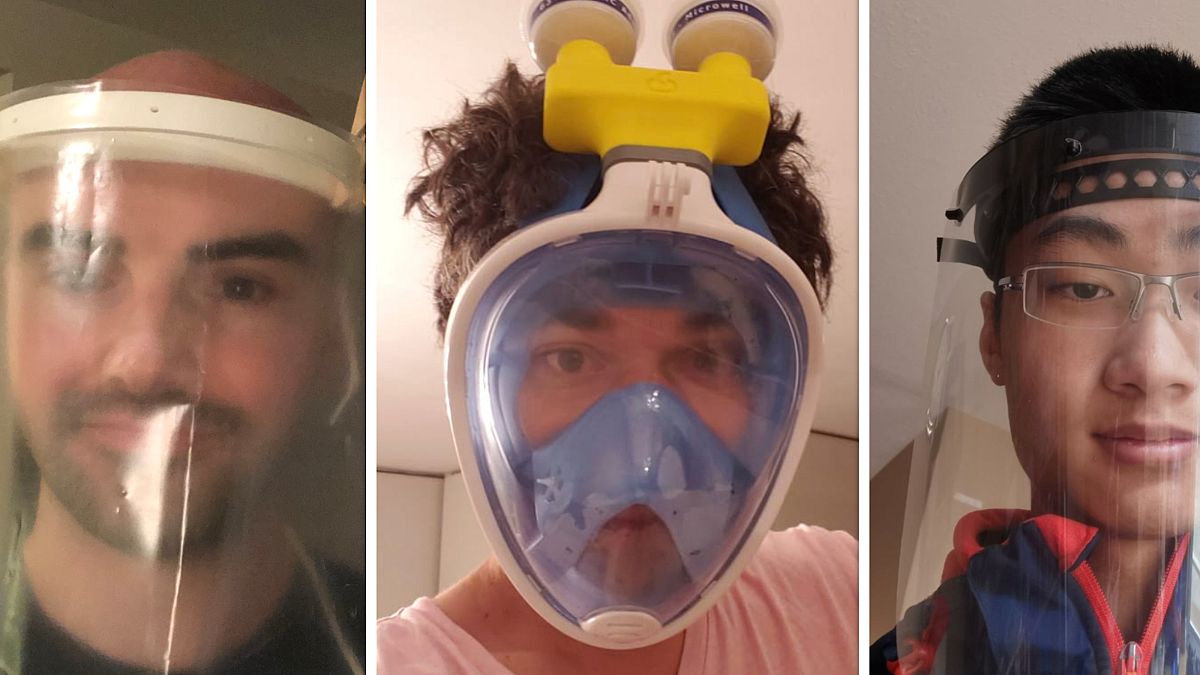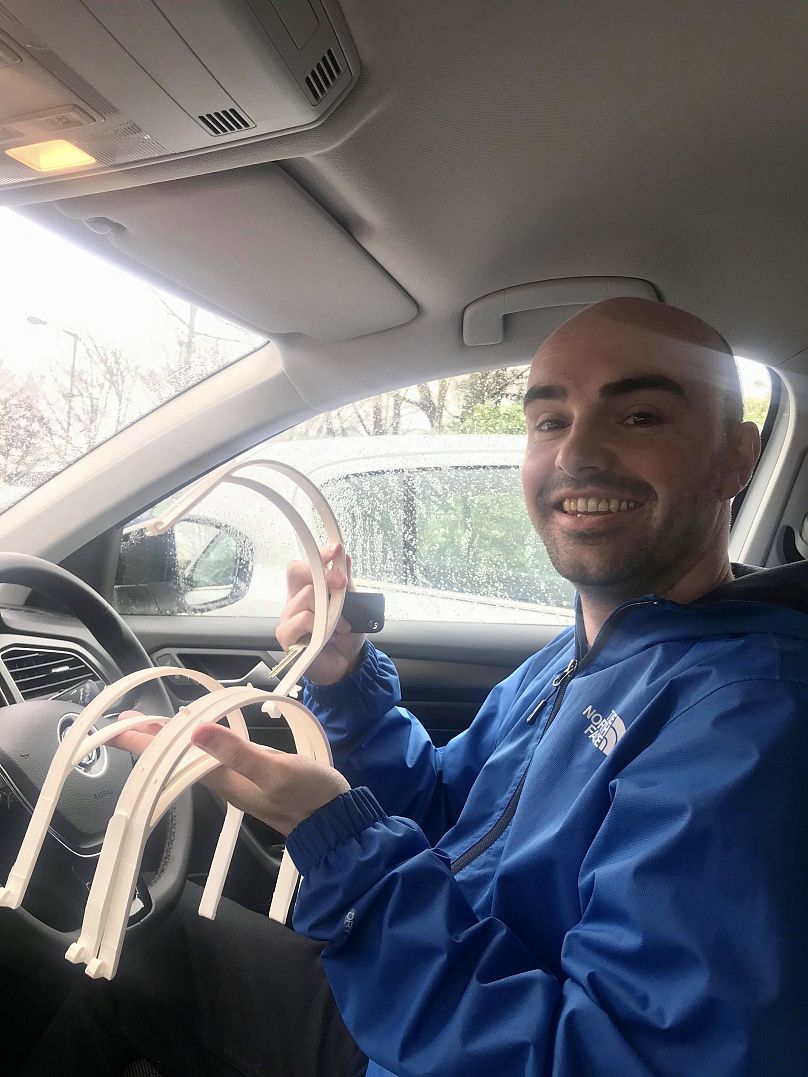As countries grapple with a shortage of stock, throngs of engineers and 3D-printing enthusiasts have banded together to come up with their own solutions.
Amid the scramble to get protective gear for health workers on the coronavirus frontline, some are being forced to turn to more innovative solutions.
As countries grapple with a shortage of stock, throngs of engineers and 3D-printing enthusiasts have banded together to come up with their own solutions.
It comes after doctors have taken to social media to plead for equipment that is in short supply, from masks to face shields.
While much of the supplies that have been created are unregulated, these innovators are working under a single premise: that, in a crisis, alternatives are better than nothing at all.
As governments work to ramp up production of protective gear, Euronews spoke with three of these innovators: a high school student, the head of an engineering company and a teacher, who have been 3D printing their own versions of protective equipment.
Can snorkeling goggles help amid a mask shortage?
Federico Acosta is an engineer, and founder of Custom Surgical, a German company specialising in producing medical equipment. Less than a week ago, Dr David Kohn, a doctor in Chile, contacted Acosta with an idea: to create a 3D printed attachment that can connect an antiviral respirator to a scuba diving mask which could offer a solution amid dwindling stock of respirators and medical masks.
"We stopped all the projects we were working on in the company and started working on this," Acosta told Euronews in an interview. The team of six has "been working non-stop over the past few days but the acceptance of the idea has been amazing," he said.
The scuba diving masks and snorkeling goggles are available on Amazon and produced by companies such as sports giant Decathlon, while Acosta's team has made their design freely available, and is encouraging those with 3D printers to create the attachments and give them to hospitals which are lacking protective equipment.
Scuba diving masks are "something that anybody can get their hands on, and that's the reason why we are implementing it with this type of device," he said.
Acosta added the masks can also be used for patients: "When the patients exhale, the air goes through these filters to protect other people from getting infected."
The masks, however, have yet to be quality tested in a lab.
"We cannot guarantee that they are impenetrable," he reaffirms. "Of course, we cannot go to a lab right now and guarantee that the virus will penetrate or not but we truly believe that it's better than using a regular mask".
The project has gained traction with volunteers based in countries such as Colombia, Chile, the USA, UK, Australia, Germany, Canada, according to Acosta, printing the devices or solving logistical issues.
"I think this is only possible because of social media and from everyone checking our project," he said.
A high school student makes face shields for his uncle in California and others
"My uncle in California will soon be put on the front lines of treating people" Sean Uy, a final-year high school student based in Canada, told Euronews. He wanted to help amid the shortage in PPE in hospitals.
"I started doing some research and seeing how I can help. Obviously, I am not a manufacturer so I can only do so much. I saw that face shields are being made. I looked for designs and saw some open source files and got my printer to work".
Regulations in countries such as the United States have been relaxed to allow for these kinds of alternatives when there is a lack of supply in approved masks.
"I am located in Canada where home-made PPEs are not allowed for use. That's because we still have the material and PPE still in Canada. But in the US, having this face shield is way better than having none at all, even though there is no certification for this. As for protection wise, definitely better than nothing."
Uy says his face shields are "a work in progress," but adds that he has been getting feedback and support from those within the 3D printing community.
"Ironically it's social distancing, but we have to work together, it doesn't have to be in a physical way. If we all go through our separate paths, there is no way we can solve this. I can only do so much".
A Facebook group called Open Source COVID19 Medical Supplies was created in early March and has now gathered over 50,000 members sharing print designs and information.
"When I published my post on Facebook saying that I needed some help making these face shields, people all over the community started asking how they could help: we have a huge print farm over here, we can make tonnes of these, we can laser cut this, we can CNC (a type of 3D printing)that. So I was blown away by the sense of community from people that I didn't know."
"I have contacts with family and addresses all over the US that are in dire need of these, but I can't fulfil those orders in time. I am not making these for profit and I am very glad that people are willing to donate these," he said.
"It's such an awesome feeling that you are helping people that, without you, and the community, would be in a much worse off position than they are now."
A teacher in Scotland makes visors from the class room
"I was asked by our local hospital to help out and produce some 3D-printed visors that they could use as protective equipment over the face," Stephen Stewart, head of computing science, business & digital technology at Lochaber High in Scotland told Euronews.
Stewart has a friend who works in mountain rescue, who heard that their local hospital in Belford was in need of PPE. He then searched online for a readily available design that could be tweaked to suit the 3D printer at the school.
"It's very much a community project where we are using our high school, where we have a 3D printer, to print a 3D mould and then a local mountain rescue team are helping to add the protective, transparent sheet on the front," he said.
In a statement, Stewart said that the reaction has been extremely positive.
"I think its something as a school we should be proud of that we are able to help out at a time of need. I’m sure any school would do the same if it has the resources to do it and I will definitely be highlighting the potential use cases for this type of technology to my pupils when we return to school".
Stewart said that organisations throughout the UK have been downloading his design that he posted on his personal Twitter account and printing similar visors through their own printers. "Up and down the country, if they can do anything to help the NHS, it is great seeing people coming together and helping out when they can".
Stewart reiterated that these visors should be used "as a last resort".
"Hopefully our hospitals will have correct PPE equipment that they can use. But it is very much a backup and as a community, we are trying to do everything that we can to help".
The European Commission has put forward recommendations they say will enable an increase of supply in PPE "such as disposable face masks to civil protection authorities, even if it is not CE-marked, without compromising our health and safety standards".

